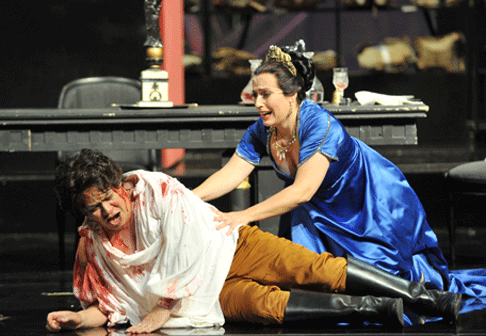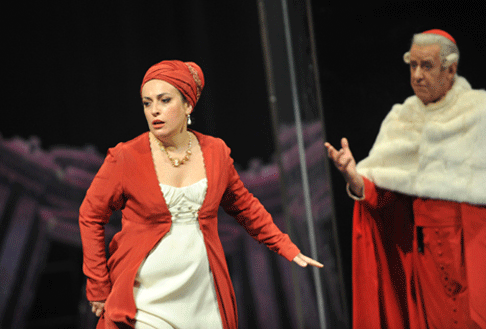15 Dec 2010
Karlsruhe Tosca: Guns ‘n’ Jesus
Badisches Staastheater’s production of Tosca starts off with a bang.

Badisches Staastheater’s production of Tosca starts off with a bang.
Literally.
A cardinal’s face appears upstage in the skylight hole of a tromp l’oeil baroque church cupola and several men are lined up on a slightly elevated platform (just a step up), facing him upstage. Then…gunshots ring out and the men fall dead to the ground. And the famous opening chords ring out as a drop cuts off the sight of their corpses.
Bear with me here, and trust me as I say if this is perhaps not the Tosca of your dreams, nor does it turn out to be the Tosca of your worst nightmares. There is much to recommend in the pared down scenic approach. If you reveled in the excesses of Zeffirelli’s Met-ravaganza, stay far away from this one, because Heinz Balthes’s church scene is largely played “in one” in front of the above mentioned drop. Panels eventually part to reveal multiple Mylar-mirrored images of the Virgin (that Cavaradossi never touches with a paint brush), but somehow the imagery is apt, handsome…even honest.
There is no visible gate to the side chapel where Angelotti hides, only a statue of Mary down left that remains there throughout. Down right is a…well…we’ll get to that later. John Dew’s direction is full of quirks, most of them fresh, some of them downright frech, all of them (save one) uncommonly intriguing. Our diva and the tenor are playfully frisky and ardent to the point that they actually spend some time lounging about on the floor of the chapel! (Honey, don’t you worry about kissing him in front of the Madonna when you were pressing against him on the tiles!)
Arguably the most sensational innovation was having Scarpia portrayed (are you seated?) as a cardinal of the church. Yes, you read it here. And well, think about it, why not? Highly placed civilians like a police chief could buy their way into position in the church, and within the context of today’s sexual misbehavior within the clergy, it added a whole extra Creep Factor to his lustful pursuit of the leading lady. Ewwwwwwwwww. Instead of merely attending the service of the Eucharist, Scarpia led it even as he plotted his sordid seduction. Double Eeeeeeeeeeeeew. In moments like these Mr. Dew provided a complex spontaneity to this Puccini War Horse that I no longer thought possible.
And Balthes’ simple sets focused the whole shebang right where it should be, on the characters. The Farnese Palace featured only a long banquet table and some doors, and that was all that was needed. What an effective cat and mouse pursuit was facilitated around that ample table. Jose Manuel Vasquez contrived vividly appropriate costumes, from the vibrant red of the cardinal’s cassock, to Tosca’s steely blue Act II satin gown, to her Norma Desmond white entrance dress with red turban and over-jacket. Gorgeously detailed, character-specific attire. Gerd Meier’s lighting was not called upon to do much more than area isolation and general washes but they were even, well colored, and for once, we saw the perfomers’ faces. And what performers they were! If you wanted you could pay ten times the ticket prices in New York or Vienna and still not see a cast this good.
 Keith Ikaia-Purdy as Cavaradossi and Barbara Dobrzanska as Tosca [Photo by Jochen Klenk courtesy of Badisches Staatstheater Karlsruhe]
Keith Ikaia-Purdy as Cavaradossi and Barbara Dobrzanska as Tosca [Photo by Jochen Klenk courtesy of Badisches Staatstheater Karlsruhe]
Barbara Dobrzanska is a local treasure who seems content to remain so, for she could conquer many an international house with her secure spinto soprano. I am not sure that I have heard anyone nail the role’s high notes with greater skill. They definitely rated a ten on the Thrill-O-Meter. Her middle and lower voice are uniform and seamless, and she never faltered in musical excellence or dramatic concentration. I did have the feeling that Ms. Dobrzanska is still somewhat feeling her way through this iconic role. There aren’t many parts that have more baggage than this one are there? I mean, to include the ghost of La Callas hovering over it. Barbara has all the skill sets in place, but as of yet there seemed to be too much control in a character than is explosive passion incarnate. Oddly, her least effective moment was probably Vissi d’arte. Oh it was exceedingly well sung, but it seemed almost an out of body experience for her. For sheer sound, stamina, and power, though, hers was a notable role assumption. And she looked as glamorous as I have ever seen her (although her gait could glide a bit more). Barbara Dobrzanska is already a very fine Tosca and as she internalizes it more, she can likely develop into one of the greats.
Keith Ikaia-Purdy was born to sing Cavaradossi, the vocal line fitting him like a glove and highlighting all his strengths. Although announced as indisposed, he called upon his solid technique to fill the house with idiomatic, heartfelt Puccinian vocalism of a very high standard indeed. His steely top notes can assuredly thrill with a ringing Vittoria and the like, but what sets him apart is his sensitivity to text and his ability to scale back his voice for nuanced phrasings. When he and his soprano got revved up in their duets, they were smokin’ and you knew you had come to the right address!
 Barbara Dobrzanska as Tosca [Photo by Jochen Klenk courtesy of Badisches Staatstheater Karlsruhe]
Barbara Dobrzanska as Tosca [Photo by Jochen Klenk courtesy of Badisches Staatstheater Karlsruhe]
Stefan Stoll was a fine foil as Scarpia, his solid, stentorian baritone fulfilling all of the demands of the part with none of the cliches. His Te Deum was memorable and a high point of the performance. His varied banter with Tosca was laden with sub-text, his character three-dimensional. Ulrich Schneider was a more sober Sacristan than is usual and while his virile baritone was pleasing to hear, the role lost some of the comic definition that usually enriches these scenes. Luiz Molz sang nicely as Angelotti but lacked that final bit of honest urgency. Hans-Jörg Weinschenk’s Spoletta and (especially) Alexander Huck’s Sciarrone were not the usual comprimario turns, but very well sung indeed with ringing tone -- welcome portrayals by two skilled performers. I somewhat missed the purity of a boy soprano as the Shepherd, but Őzgecan Gençer won me over with her sweet account of the Act III opening.
Conductor Jochem Hochstenbach had the band in good order, and the ensemble between stage and pit was commendable. There might have been a little more indulgence in give and take with the principles but the whole performance was tidy and stylistically sound. Hans-Jörg Kalmbach’s childrens’ chorus was notably well prepared.
The one mega-major-mucho miscalculation was alas, saved for last. First off (and this is not it), instead of jumping to her death, Tosca instead gets shot dead like the line-up of extras in the opening. You are thinking: “That’s not it????” Admit it. You are.
No, after her “different” demise, a statue of scourged Jesus that had been placed down right suddenly comes to life. Clad in what seems to be Depends, a diaphanous red cloak, and a crown of thorns out of Martha Stewart Living,our Lord sprints over to the corpse. This was undoubtedly meant to somehow be an avanti a Dio moment but really, the way the super flitted, it came off more: “Gurl, waddamaddawidyougetupoffadatfloorandrun!” Where was another bullet when you needed it…?
James Sohre